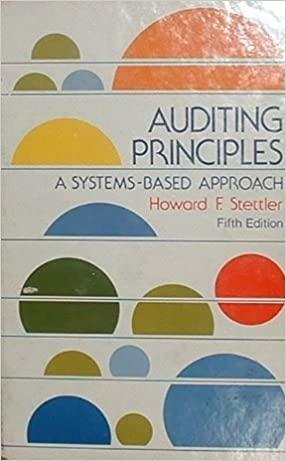Answered step by step
Verified Expert Solution
Question
1 Approved Answer
only two questions, looks long but really is not. please complete the right way please answer asap, clear pictures INTRODUCTION Janet McKinley is employed by
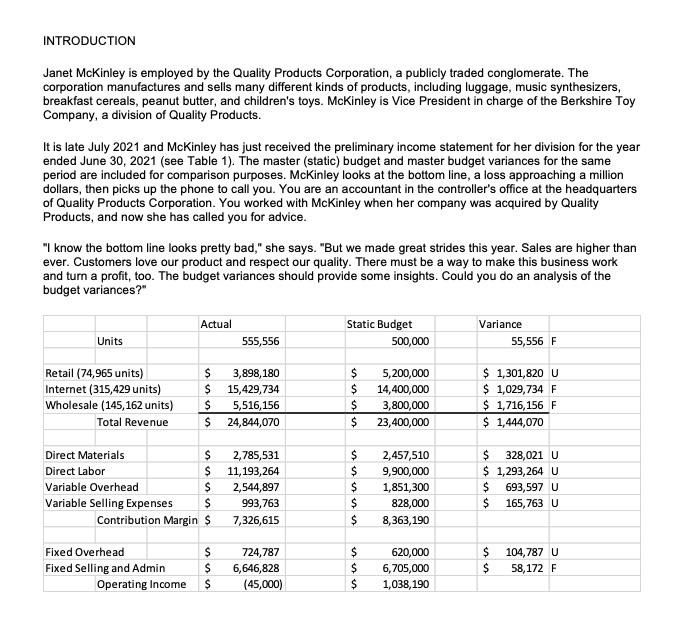
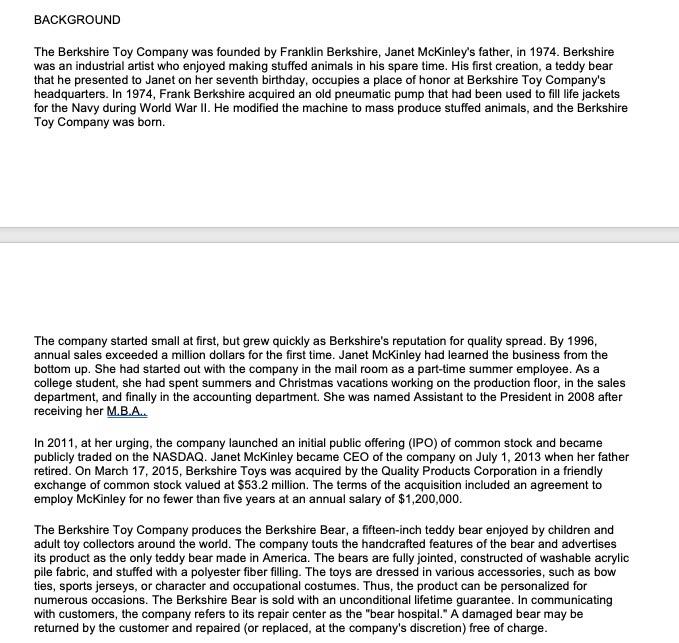
only two questions, looks long but really is not. please complete the right way
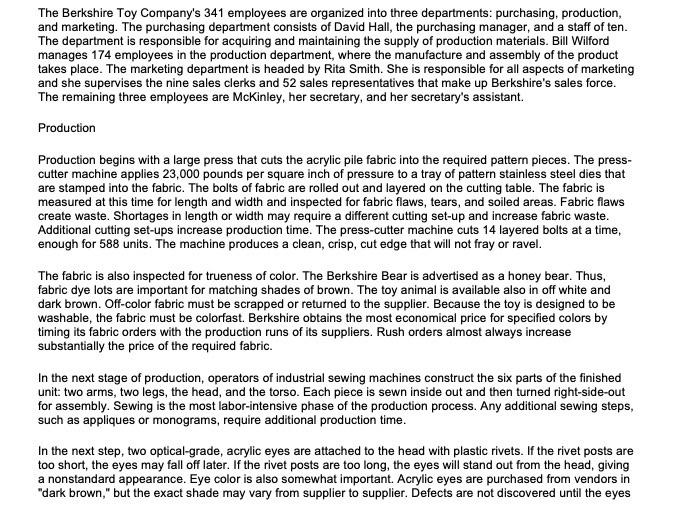
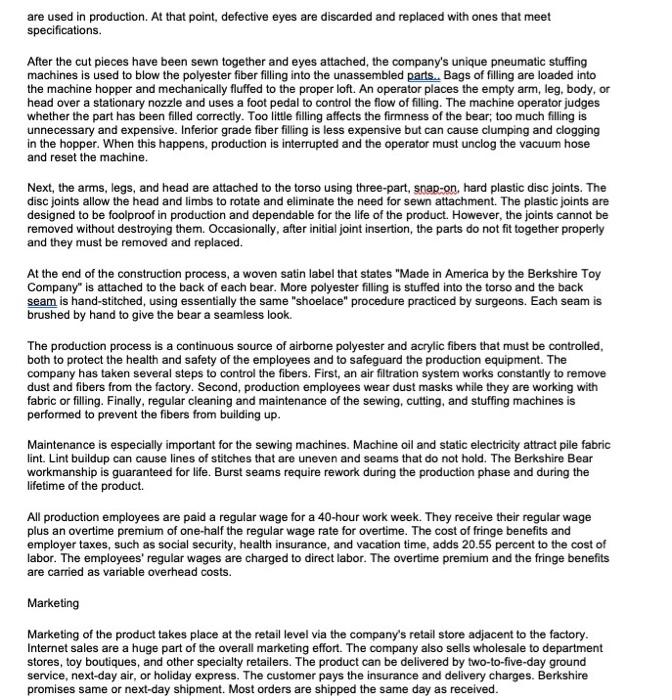
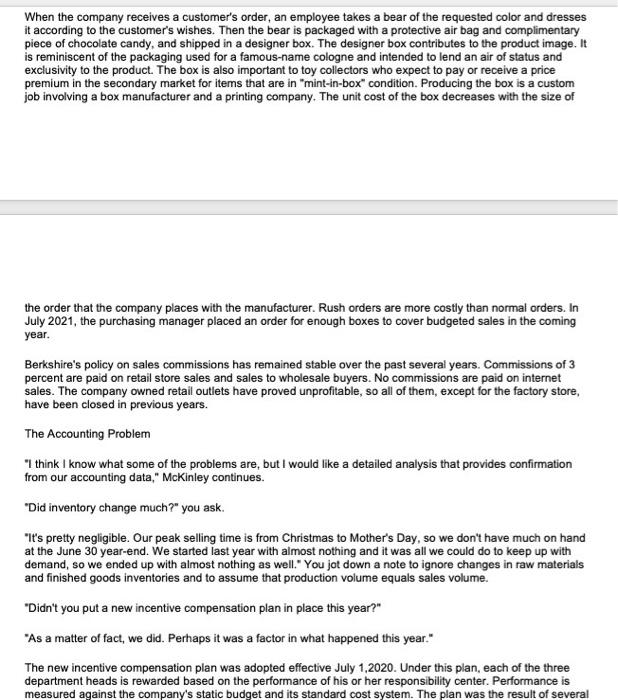
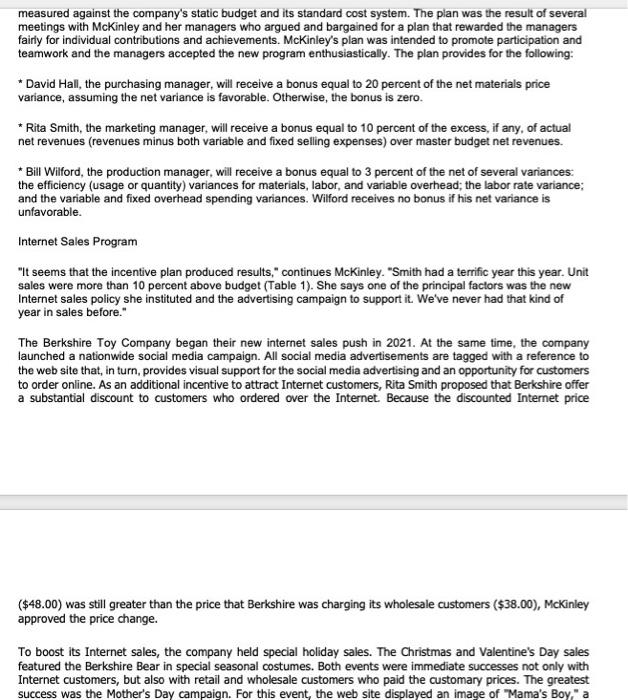
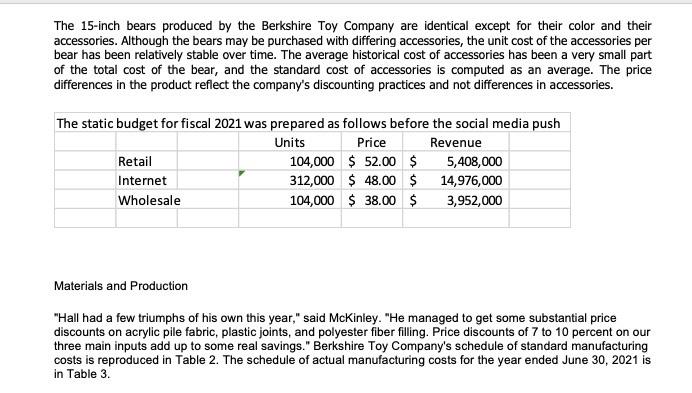
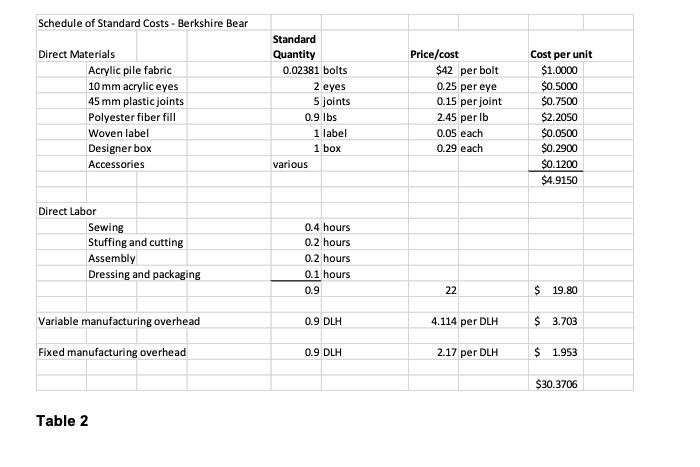
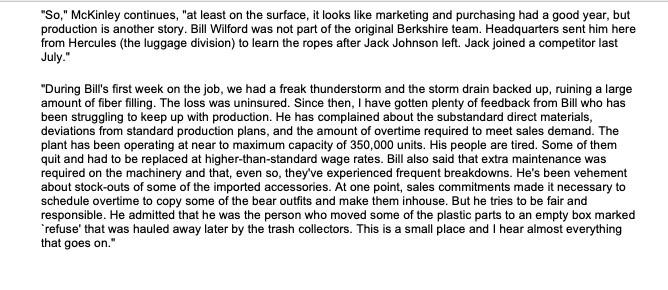
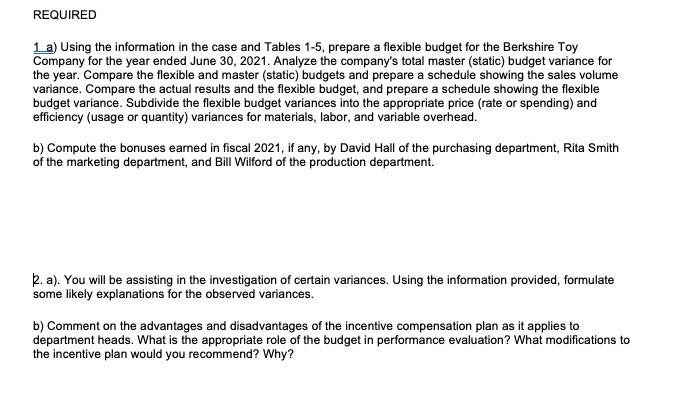
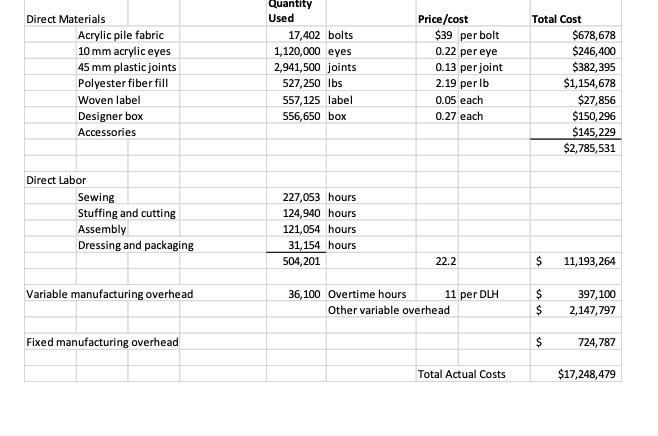
please answer asap, clear pictures
INTRODUCTION Janet McKinley is employed by the Quality Products Corporation, a publicly traded conglomerate. The corporation manufactures and sells many different kinds of products, including luggage, music synthesizers, breakfast cereals, peanut butter, and children's toys. McKinley is Vice President in charge of the Berkshire Toy Company, a division of Quality Products. It is late July 2021 and McKinley has just received the preliminary income statement for her division for the year ended June 30, 2021 (see Table 1). The master (static) budget and master budget variances for the same period are included for comparison purposes. McKinley looks at the bottom line, a loss approaching a million dollars, then picks up the phone to call you. You are an accountant in the controller's office at the headquarters of Quality Products Corporation. You worked with McKinley when her company was acquired by Quality Products, and now she has called you for advice. "I know the bottom line looks pretty bad," she says. "But we made great strides this year. Sales are higher than ever. Customers love our product and respect our quality. There must be a way to make this business work and turn a profit, too. The budget variances should provide some insights. Could you do an analysis of the budget variances?" Actual Static Budget Variance Units 555,556 500,000 55,556 F Retail (74,965 units) $ $ 5,200,000 $ 1,301,820 U Internet (315,429 units) $ $ 14,400,000 3,898, 180 15,429,734 5,516,156 $ 24,844,070 $ 1,029,734 F $ 1,716,156 F Wholesale (145,162 units) $ $ 3,800,000 23,400,000 Total Revenue $ 1,444,070 Direct Materials $ 2,785,531 $ Direct Labor $ 11,193,264 2,457,510 9,900,000 1,851,300 828,000 $ 328,021 U $ 1,293,264 U $ 693,597 U 165,763 U Variable Overhead $ 2,544,897 993,763 Variable Selling Expenses $ $ Contribution Margin $ 7,326,615 8,363,190 Fixed Overhead $ 724,787 $ 104,787 U 620,000 6,705,000 Fixed Selling and Admin $ 58,172 F 6,646,828 (45,000) $ 1,038,190 Operating Income sssss $ $ $ $ sss $ HON ss $ BACKGROUND The Berkshire Toy Company was founded by Franklin Berkshire, Janet McKinley's father, in 1974. Berkshire was an industrial artist who enjoyed making stuffed animals in his spare time. His first creation, a teddy bear that he presented to Janet on her seventh birthday, occupies a place of honor at Berkshire Toy Company's headquarters. In 1974, Frank Berkshire acquired an old pneumatic pump that had been used to fill life jackets for the Navy during World War II. He modified the machine to mass produce stuffed animals, and the Berkshire Toy Company was born. The company started small at first, but grew quickly as Berkshire's reputation for quality spread. By 1996, annual sales exceeded a million dollars for the first time. Janet McKinley had learned the business from the bottom up. She had started out with the company in the mail room as a part-time summer employee. As a college student, she had spent summers and Christmas vacations working on the production floor, in the sales department, and finally in the accounting department. She was named Assistant to the President in 2008 after receiving her M.B.A.. In 2011, at her urging, the company launched an initial public offering (IPO) of common stock and became publicly traded on the NASDAQ. Janet McKinley became CEO of the company on July 1, 2013 when her father retired. On March 17, 2015, Berkshire Toys was acquired by the Quality Products Corporation in a friendly exchange of common stock valued at $53.2 million. The terms of the acquisition included an agreement to employ McKinley for no fewer than five years at an annual salary of $1,200,000. The Berkshire Toy Company produces the Berkshire Bear, a fifteen-inch teddy bear enjoyed by children and adult toy collectors around the world. The company touts the handcrafted features of the bear and advertises its product as the only teddy bear made in America. The bears are fully jointed, constructed of washable acrylic pile fabric, and stuffed with a polyester fiber filling. The toys are dressed in various accessories, such as bow ties, sports jerseys, or character and occupational costumes. Thus, the product can be personalized for numerous occasions. The Berkshire Bear is sold with an unconditional lifetime guarantee. In communicating with customers, the company refers to its repair center as the "bear hospital." A damaged bear may be returned by the customer and repaired (or replaced, at the company's discretion) free of charge. The Berkshire Toy Company's 341 employees are organized into three departments: purchasing, production, and marketing. The purchasing department consists of David Hall, the purchasing manager, and a staff of ten. The department is responsible for acquiring and maintaining the supply of production materials. Bill Wilford manages 174 employees in the production department, where the manufacture and assembly of the product takes place. The marketing department is headed by Rita Smith. She is responsible for all aspects of marketing and she supervises the nine sales clerks and 52 sales representatives that make up Berkshire's sales force. The remaining three employees are McKinley, her secretary, and her secretary's assistant. Production Production begins with a large press that cuts the acrylic pile fabric into the required pattern pieces. The press- cutter machine applies 23,000 pounds per square inch of pressure to a tray of pattern stainless steel dies that are stamped into the fabric. The bolts of fabric are rolled out and layered on the cutting table. The fabric is measured at this time for length and width and inspected for fabric flaws, tears, and soiled areas. Fabric flaws create waste. Shortages in length or width may require a different cutting set-up and increase fabric waste. Additional cutting set-ups increase production time. The press-cutter machine cuts 14 layered bolts at a time, enough for 588 units. The machine produces a clean, crisp, cut edge that will not fray or ravel. The fabric is also inspected for trueness of color. The Berkshire Bear is advertised as a honey bear. Thus, fabric dye lots are important for matching shades of brown. The toy animal is available also in off white and dark brown. Off-color fabric must be scrapped or returned to the supplier. Because the toy is designed to be washable, the fabric must be colorfast. Berkshire obtains the most economical price for specified colors by timing its fabric orders with the production runs of its suppliers. Rush orders almost always increase substantially the price of the required fabric. In the next stage of production, operators of industrial sewing machines construct the six parts of the finished unit: two arms, two legs, the head, and the torso. Each piece is sewn inside out and then turned right-side-out for assembly. Sewing is the most labor-intensive phase of the production process. Any additional sewing steps, such as appliques or monograms, require additional production time. In the next step, two optical-grade, acrylic eyes are attached to the head with plastic rivets. If the rivet posts are too short, the eyes may fall off later. If the rivet posts are too long, the eyes will stand out from the head, giving a nonstandard appearance. Eye color is also somewhat important. Acrylic eyes are purchased from vendors in "dark brown," but the exact shade may vary from supplier to supplier. Defects are not discovered until the eyes are used in production. At that point, defective eyes are discarded and replaced with ones that meet specifications. After the cut pieces have been sewn together and eyes attached, the company's unique pneumatic stuffing machines is used to blow the polyester fiber filling into the unassembled parts... Bags of filling are loaded into the machine hopper and mechanically fluffed to the proper loft. An operator places the empty arm, leg, body, or head over a stationary nozzle and uses a foot pedal to control the flow of filling. The machine operator judges whether the part has been filled correctly. Too little filling affects the firmness of the bear; too much filling is unnecessary and expensive. Inferior grade fiber filling is less expensive but can cause clumping and clogging in the hopper. When this happens, production is interrupted and the operator must unclog the vacuum hose and reset the machine. Next, the arms, legs, and head are attached to the torso using three-part, snap-on, hard plastic disc joints. The disc joints allow the head and limbs to rotate and eliminate the need for sewn attachment. The plastic joints are designed to be foolproof in production and dependable for the life of the product. However, the joints cannot be removed without destroying them. Occasionally, after initial joint insertion, the parts do not fit together properly and they must be removed and replaced. At the end of the construction process, a woven satin label that states "Made in America by the Berkshire Toy Company" is attached to the back of each bear. More polyester filling is stuffed into the torso and the back seam is hand-stitched, using essentially the same "shoelace" procedure practiced by surgeons. Each seam is brushed by hand to give the bear a seamless look. The production process is a continuous source of airborne polyester and acrylic fibers that must be controlled, both to protect the health and safety of the employees and to safeguard the production equipment. The company has taken several steps to control the fibers. First, an air filtration system works constantly to remove dust and fibers from the factory. Second, production employees wear dust masks while they are working with fabric or filling. Finally, regular cleaning and maintenance of the sewing, cutting, and stuffing machines is performed to prevent the fibers from building up. Maintenance is especially important for the sewing machines. Machine oil and static electricity attract pile fabric lint. Lint buildup can cause lines of stitches that are uneven and seams that do not hold. The Berkshire Bear workmanship is guaranteed for life. Burst seams require rework during the production phase and during the lifetime of the product. All production employees are paid a regular wage for a 40-hour work week. They receive their regular wage plus an overtime premium of one-half the regular wage rate for overtime. The cost of fringe benefits and employer taxes, such as social security, health insurance, and vacation time, adds 20.55 percent to the cost of labor. The employees' regular wages are charged to direct labor. The overtime premium and the fringe benefits are carried as variable overhead costs. Marketing Marketing of the product takes place at the retail level via the company's retail store adjacent to the factory. Internet sales are a huge part of the overall marketing effort. The company also sells wholesale to department stores, toy boutiques, and other specialty retailers. The product can be delivered by two-to-five-day ground service, next-day air, or holiday express. The customer pays the insurance and delivery charges. Berkshire promises same or next-day shipment. Most orders are shipped the same day as received. When the company receives a customer's order, an employee takes a bear of the requested color and dresses it according to the customer's wishes. Then the bear is packaged with a protective air bag and complimentary piece of chocolate candy, and shipped in a designer box. The designer box contributes to the product image. It is reminiscent of the packaging used for a famous-name cologne and intended to lend an air of status and exclusivity to the product. The box is also important to toy collectors who expect to pay or receive a price premium in the secondary market for items that are in "mint-in-box" condition. Producing the box is a custom job involving a box manufacturer and a printing company. The unit cost of the box decreases with the size of the order that the company places with the manufacturer. Rush orders are more costly than normal orders. In July 2021, the purchasing manager placed an order for enough boxes to cover budgeted sales in the coming year. Berkshire's policy on sales commissions has remained stable over the past several years. Commissions of 3 percent are paid on retail store sales and sales to wholesale buyers. No commissions are paid on internet sales. The company owned retail outlets have proved unprofitable, so all of them, except for the factory store, have been closed in previous years. The Accounting Problem "I think I know what some of the problems are, but I would like a detailed analysis that provides confirmation from our accounting data," McKinley continues. "Did inventory change much?" you ask. "It's pretty negligible. Our peak selling time is from Christmas to Mother's Day, so we don't have much on hand at the June 30 year-end. We started last year with almost nothing and it was all we could do to keep up with demand, so we ended up with almost nothing as well." You jot down a note to ignore changes in raw materials and finished goods inventories and to assume that production volume equals sales volume. "Didn't you put a new incentive compensation plan in place this year?" "As a matter of fact, we did. Perhaps it was a factor in what happened this year." The new incentive compensation plan was adopted effective July 1,2020. Under this plan, each of the three department heads is rewarded based on the performance of his or her responsibility center. Performance is measured against the company's static budget and its standard cost system. The plan was the result of several measured against the company's static budget and its standard cost system. The plan was the result of several meetings with McKinley and her managers who argued and bargained for a plan that rewarded the managers fairly for individual contributions and achievements. McKinley's plan was intended to promote participation and teamwork and the managers accepted the new program enthusiastically. The plan provides for the following: * David Hall, the purchasing manager, will receive a bonus equal to 20 percent of the net materials price variance, assuming the net variance is favorable. Otherwise, the bonus is zero. * Rita Smith, the marketing manager, will receive a bonus equal to 10 percent of the excess, if any, of actual net revenues (revenues minus both variable and fixed selling expenses) over master budget net revenues. * Bill Wilford, the production manager, will receive a bonus equal to 3 percent of the net of several variances: the efficiency (usage or quantity) variances for materials, labor, and variable overhead; the labor rate variance; and the variable and fixed overhead spending variances. Wilford receives no bonus if his net variance is unfavorable. Internet Sales Program "It seems that the incentive plan produced results," continues McKinley. "Smith had a terrific year this year. Unit sales were more than 10 percent above budget (Table 1). She says one of the principal factors was the new Internet sales policy she instituted and the advertising campaign to support it. We've never had that kind of year in sales before." The Berkshire Toy Company began their new internet sales push in 2021. At the same time, the company launched a nationwide social media campaign. All social media advertisements are tagged with a reference to the web site that, in turn, provides visual support for the social media advertising and an opportunity for customers to order online. As an additional incentive to attract Internet customers, Rita Smith proposed that Berkshire offer a substantial discount to customers who ordered over the Internet. Because the discounted Internet price ($48.00) was still greater than the price that Berkshire was charging its wholesale customers ($38.00), McKinley approved the price change. To boost its Internet sales, the company held special holiday sales. The Christmas and Valentine's Day sales featured the Berkshire Bear in special seasonal costumes. Both events were immediate successes not only with Internet customers, but also with retail and wholesale customers who paid the customary prices. The greatest success was the Mother's Day campaign. For this event, the web site displayed an image of "Mama's Boy," a The 15-inch bears produced by the Berkshire Toy Company are identical except for their color and their accessories. Although the bears may be purchased with differing accessories, the unit cost of the accessories per bear has been relatively stable over time. The average historical cost of accessories has been a very small part of the total cost of the bear, and the standard cost of accessories is computed as an average. The price differences in the product reflect the company's discounting practices and not differences in accessories. The static budget for fiscal 2021 was prepared as follows before the social media push Units Revenue Price 104,000 $52.00 $ 5,408,000 Retail Internet 312,000 $48.00 $ 14,976,000 3,952,000 Wholesale 104,000 $38.00 $ Materials and Production "Hall had a few triumphs of his own this year," said McKinley. "He managed to get some substantial price discounts on acrylic pile fabric, plastic joints, and polyester fiber filling. Price discounts of 7 to 10 percent on our three main inputs add up to some real savings." Berkshire Toy Company's schedule of standard manufacturing costs is reproduced in Table 2. The schedule of actual manufacturing costs for the year ended June 30, 2021 is in Table 3. Schedule of Standard Costs - Berkshire Bear Direct Materials Acrylic pile fabric 10 mm acrylic eyes 45 mm plastic joints Polyester fiber fill Woven label Designer box Accessories Sewing Stuffing and cutting Assembly Dressing and packaging Variable manufacturing overhead Fixed manufacturing overhead Table 2 Direct Labor Standard Quantity 0.02381 bolts 2 eyes 5 joints 1 label 1 box 0.4 hours 0.2 hours 0.2 hours 0.1 hours 0.9 0.9 DLH 0.9 DLH 0.9 lbs various Price/cost $42 per bolt 0.25 per eye 0.15 per joint 2.45 per lb 0.05 each 0.29 each 22 4.114 per DLH 2.17 per DLH Cost per unit $1.0000 $0.5000 $0.7500 $2.2050 $0.0500 $0.2900 $0.1200 $4.9150 $19.80 $ 3.703 $ 1.953 $30.3706 "So," McKinley continues, "at least on the surface, it looks like marketing and purchasing had a good year, but production is another story. Bill Wilford was not part of the original Berkshire team. Headquarters sent him here from Hercules (the luggage division) to learn the ropes after Jack Johnson left. Jack joined a competitor last July." "During Bill's first week on the job, we had a freak thunderstorm and the storm drain backed up, ruining a large amount of fiber filling. The loss was uninsured. Since then, I have gotten plenty of feedback from Bill who has been struggling to keep up with production. He has complained about the substandard direct materials, deviations from standard production plans, and the amount of overtime required to meet sales demand. The plant has been operating at near to maximum capacity of 350,000 units. His people are tired. Some of them quit and had to be replaced at higher-than-standard wage rates. Bill also said that extra maintenance was required on the machinery and that, even so, they've experienced frequent breakdowns. He's been vehement about stock-outs of some of the imported accessories. At one point, sales commitments made it necessary to schedule overtime to copy some of the bear outfits and make them inhouse. But he tries to be fair and responsible. He admitted that he was the person who moved some of the plastic parts to an empty box marked `refuse' that was hauled away later by the trash collectors. This is a small place and I hear almost everything that goes on." REQUIRED 1a) Using the information in the case and Tables 1-5, prepare a flexible budget for the Berkshire Toy Company for the year ended June 30, 2021. Analyze the company's total master (static) budget variance for the year. Compare the flexible and master (static) budgets and prepare a schedule showing the sales volume variance. Compare the actual results and the flexible budget, and prepare a schedule showing the flexible budget variance. Subdivide the flexible budget variances into the appropriate price (rate or spending) and efficiency (usage or quantity) variances for materials, labor, and variable overhead. b) Compute the bonuses earned in fiscal 2021, if any, by David Hall of the purchasing department, Rita Smith of the marketing department, and Bill Wilford of the production department. 2. a). You will be assisting in the investigation of certain variances. Using the information provided, formulate some likely explanations for the observed variances. b) Comment on the advantages and disadvantages of the incentive compensation plan as it applies to department heads. What is the appropriate role of the budget in performance evaluation? What modifications to the incentive plan would you recommend? Why? Direct Materials Acrylic pile fabric 10 mm acrylic eyes 45 mm plastic joints Polyester fiber fill Woven label Designer box Accessories Sewing Stuffing and cutting Assembly Dressing and packaging Variable manufacturing overhead Fixed manufacturing overhead Direct Labor Quantity Used 17,402 bolts 1,120,000 eyes 2,941,500 joints 527,250 lbs 557,125 label 556,650 box 227,053 hours 124,940 hours 121,054 hours 31,154 hours 504,201 36,100 Overtime hours Price/cost $39 per bolt 0.22 per eye 0.13 per joint 2.19 per lb 0.05 each 0.27 each 22.2 11 per DLH Total Actual Costs Other variable overhead Total Cost $ $ $ $ $678,678 $246,400 $382,395 $1,154,678 $27,856 $150,296 $145,229 $2,785,531 11,193,264 397,100 2,147,797 724,787 $17,248,479 INTRODUCTION Janet McKinley is employed by the Quality Products Corporation, a publicly traded conglomerate. The corporation manufactures and sells many different kinds of products, including luggage, music synthesizers, breakfast cereals, peanut butter, and children's toys. McKinley is Vice President in charge of the Berkshire Toy Company, a division of Quality Products. It is late July 2021 and McKinley has just received the preliminary income statement for her division for the year ended June 30, 2021 (see Table 1). The master (static) budget and master budget variances for the same period are included for comparison purposes. McKinley looks at the bottom line, a loss approaching a million dollars, then picks up the phone to call you. You are an accountant in the controller's office at the headquarters of Quality Products Corporation. You worked with McKinley when her company was acquired by Quality Products, and now she has called you for advice. "I know the bottom line looks pretty bad," she says. "But we made great strides this year. Sales are higher than ever. Customers love our product and respect our quality. There must be a way to make this business work and turn a profit, too. The budget variances should provide some insights. Could you do an analysis of the budget variances?" Actual Static Budget Variance Units 555,556 500,000 55,556 F Retail (74,965 units) $ $ 5,200,000 $ 1,301,820 U Internet (315,429 units) $ $ 14,400,000 3,898, 180 15,429,734 5,516,156 $ 24,844,070 $ 1,029,734 F $ 1,716,156 F Wholesale (145,162 units) $ $ 3,800,000 23,400,000 Total Revenue $ 1,444,070 Direct Materials $ 2,785,531 $ Direct Labor $ 11,193,264 2,457,510 9,900,000 1,851,300 828,000 $ 328,021 U $ 1,293,264 U $ 693,597 U 165,763 U Variable Overhead $ 2,544,897 993,763 Variable Selling Expenses $ $ Contribution Margin $ 7,326,615 8,363,190 Fixed Overhead $ 724,787 $ 104,787 U 620,000 6,705,000 Fixed Selling and Admin $ 58,172 F 6,646,828 (45,000) $ 1,038,190 Operating Income sssss $ $ $ $ sss $ HON ss $ BACKGROUND The Berkshire Toy Company was founded by Franklin Berkshire, Janet McKinley's father, in 1974. Berkshire was an industrial artist who enjoyed making stuffed animals in his spare time. His first creation, a teddy bear that he presented to Janet on her seventh birthday, occupies a place of honor at Berkshire Toy Company's headquarters. In 1974, Frank Berkshire acquired an old pneumatic pump that had been used to fill life jackets for the Navy during World War II. He modified the machine to mass produce stuffed animals, and the Berkshire Toy Company was born. The company started small at first, but grew quickly as Berkshire's reputation for quality spread. By 1996, annual sales exceeded a million dollars for the first time. Janet McKinley had learned the business from the bottom up. She had started out with the company in the mail room as a part-time summer employee. As a college student, she had spent summers and Christmas vacations working on the production floor, in the sales department, and finally in the accounting department. She was named Assistant to the President in 2008 after receiving her M.B.A.. In 2011, at her urging, the company launched an initial public offering (IPO) of common stock and became publicly traded on the NASDAQ. Janet McKinley became CEO of the company on July 1, 2013 when her father retired. On March 17, 2015, Berkshire Toys was acquired by the Quality Products Corporation in a friendly exchange of common stock valued at $53.2 million. The terms of the acquisition included an agreement to employ McKinley for no fewer than five years at an annual salary of $1,200,000. The Berkshire Toy Company produces the Berkshire Bear, a fifteen-inch teddy bear enjoyed by children and adult toy collectors around the world. The company touts the handcrafted features of the bear and advertises its product as the only teddy bear made in America. The bears are fully jointed, constructed of washable acrylic pile fabric, and stuffed with a polyester fiber filling. The toys are dressed in various accessories, such as bow ties, sports jerseys, or character and occupational costumes. Thus, the product can be personalized for numerous occasions. The Berkshire Bear is sold with an unconditional lifetime guarantee. In communicating with customers, the company refers to its repair center as the "bear hospital." A damaged bear may be returned by the customer and repaired (or replaced, at the company's discretion) free of charge. The Berkshire Toy Company's 341 employees are organized into three departments: purchasing, production, and marketing. The purchasing department consists of David Hall, the purchasing manager, and a staff of ten. The department is responsible for acquiring and maintaining the supply of production materials. Bill Wilford manages 174 employees in the production department, where the manufacture and assembly of the product takes place. The marketing department is headed by Rita Smith. She is responsible for all aspects of marketing and she supervises the nine sales clerks and 52 sales representatives that make up Berkshire's sales force. The remaining three employees are McKinley, her secretary, and her secretary's assistant. Production Production begins with a large press that cuts the acrylic pile fabric into the required pattern pieces. The press- cutter machine applies 23,000 pounds per square inch of pressure to a tray of pattern stainless steel dies that are stamped into the fabric. The bolts of fabric are rolled out and layered on the cutting table. The fabric is measured at this time for length and width and inspected for fabric flaws, tears, and soiled areas. Fabric flaws create waste. Shortages in length or width may require a different cutting set-up and increase fabric waste. Additional cutting set-ups increase production time. The press-cutter machine cuts 14 layered bolts at a time, enough for 588 units. The machine produces a clean, crisp, cut edge that will not fray or ravel. The fabric is also inspected for trueness of color. The Berkshire Bear is advertised as a honey bear. Thus, fabric dye lots are important for matching shades of brown. The toy animal is available also in off white and dark brown. Off-color fabric must be scrapped or returned to the supplier. Because the toy is designed to be washable, the fabric must be colorfast. Berkshire obtains the most economical price for specified colors by timing its fabric orders with the production runs of its suppliers. Rush orders almost always increase substantially the price of the required fabric. In the next stage of production, operators of industrial sewing machines construct the six parts of the finished unit: two arms, two legs, the head, and the torso. Each piece is sewn inside out and then turned right-side-out for assembly. Sewing is the most labor-intensive phase of the production process. Any additional sewing steps, such as appliques or monograms, require additional production time. In the next step, two optical-grade, acrylic eyes are attached to the head with plastic rivets. If the rivet posts are too short, the eyes may fall off later. If the rivet posts are too long, the eyes will stand out from the head, giving a nonstandard appearance. Eye color is also somewhat important. Acrylic eyes are purchased from vendors in "dark brown," but the exact shade may vary from supplier to supplier. Defects are not discovered until the eyes are used in production. At that point, defective eyes are discarded and replaced with ones that meet specifications. After the cut pieces have been sewn together and eyes attached, the company's unique pneumatic stuffing machines is used to blow the polyester fiber filling into the unassembled parts... Bags of filling are loaded into the machine hopper and mechanically fluffed to the proper loft. An operator places the empty arm, leg, body, or head over a stationary nozzle and uses a foot pedal to control the flow of filling. The machine operator judges whether the part has been filled correctly. Too little filling affects the firmness of the bear; too much filling is unnecessary and expensive. Inferior grade fiber filling is less expensive but can cause clumping and clogging in the hopper. When this happens, production is interrupted and the operator must unclog the vacuum hose and reset the machine. Next, the arms, legs, and head are attached to the torso using three-part, snap-on, hard plastic disc joints. The disc joints allow the head and limbs to rotate and eliminate the need for sewn attachment. The plastic joints are designed to be foolproof in production and dependable for the life of the product. However, the joints cannot be removed without destroying them. Occasionally, after initial joint insertion, the parts do not fit together properly and they must be removed and replaced. At the end of the construction process, a woven satin label that states "Made in America by the Berkshire Toy Company" is attached to the back of each bear. More polyester filling is stuffed into the torso and the back seam is hand-stitched, using essentially the same "shoelace" procedure practiced by surgeons. Each seam is brushed by hand to give the bear a seamless look. The production process is a continuous source of airborne polyester and acrylic fibers that must be controlled, both to protect the health and safety of the employees and to safeguard the production equipment. The company has taken several steps to control the fibers. First, an air filtration system works constantly to remove dust and fibers from the factory. Second, production employees wear dust masks while they are working with fabric or filling. Finally, regular cleaning and maintenance of the sewing, cutting, and stuffing machines is performed to prevent the fibers from building up. Maintenance is especially important for the sewing machines. Machine oil and static electricity attract pile fabric lint. Lint buildup can cause lines of stitches that are uneven and seams that do not hold. The Berkshire Bear workmanship is guaranteed for life. Burst seams require rework during the production phase and during the lifetime of the product. All production employees are paid a regular wage for a 40-hour work week. They receive their regular wage plus an overtime premium of one-half the regular wage rate for overtime. The cost of fringe benefits and employer taxes, such as social security, health insurance, and vacation time, adds 20.55 percent to the cost of labor. The employees' regular wages are charged to direct labor. The overtime premium and the fringe benefits are carried as variable overhead costs. Marketing Marketing of the product takes place at the retail level via the company's retail store adjacent to the factory. Internet sales are a huge part of the overall marketing effort. The company also sells wholesale to department stores, toy boutiques, and other specialty retailers. The product can be delivered by two-to-five-day ground service, next-day air, or holiday express. The customer pays the insurance and delivery charges. Berkshire promises same or next-day shipment. Most orders are shipped the same day as received. When the company receives a customer's order, an employee takes a bear of the requested color and dresses it according to the customer's wishes. Then the bear is packaged with a protective air bag and complimentary piece of chocolate candy, and shipped in a designer box. The designer box contributes to the product image. It is reminiscent of the packaging used for a famous-name cologne and intended to lend an air of status and exclusivity to the product. The box is also important to toy collectors who expect to pay or receive a price premium in the secondary market for items that are in "mint-in-box" condition. Producing the box is a custom job involving a box manufacturer and a printing company. The unit cost of the box decreases with the size of the order that the company places with the manufacturer. Rush orders are more costly than normal orders. In July 2021, the purchasing manager placed an order for enough boxes to cover budgeted sales in the coming year. Berkshire's policy on sales commissions has remained stable over the past several years. Commissions of 3 percent are paid on retail store sales and sales to wholesale buyers. No commissions are paid on internet sales. The company owned retail outlets have proved unprofitable, so all of them, except for the factory store, have been closed in previous years. The Accounting Problem "I think I know what some of the problems are, but I would like a detailed analysis that provides confirmation from our accounting data," McKinley continues. "Did inventory change much?" you ask. "It's pretty negligible. Our peak selling time is from Christmas to Mother's Day, so we don't have much on hand at the June 30 year-end. We started last year with almost nothing and it was all we could do to keep up with demand, so we ended up with almost nothing as well." You jot down a note to ignore changes in raw materials and finished goods inventories and to assume that production volume equals sales volume. "Didn't you put a new incentive compensation plan in place this year?" "As a matter of fact, we did. Perhaps it was a factor in what happened this year." The new incentive compensation plan was adopted effective July 1,2020. Under this plan, each of the three department heads is rewarded based on the performance of his or her responsibility center. Performance is measured against the company's static budget and its standard cost system. The plan was the result of several measured against the company's static budget and its standard cost system. The plan was the result of several meetings with McKinley and her managers who argued and bargained for a plan that rewarded the managers fairly for individual contributions and achievements. McKinley's plan was intended to promote participation and teamwork and the managers accepted the new program enthusiastically. The plan provides for the following: * David Hall, the purchasing manager, will receive a bonus equal to 20 percent of the net materials price variance, assuming the net variance is favorable. Otherwise, the bonus is zero. * Rita Smith, the marketing manager, will receive a bonus equal to 10 percent of the excess, if any, of actual net revenues (revenues minus both variable and fixed selling expenses) over master budget net revenues. * Bill Wilford, the production manager, will receive a bonus equal to 3 percent of the net of several variances: the efficiency (usage or quantity) variances for materials, labor, and variable overhead; the labor rate variance; and the variable and fixed overhead spending variances. Wilford receives no bonus if his net variance is unfavorable. Internet Sales Program "It seems that the incentive plan produced results," continues McKinley. "Smith had a terrific year this year. Unit sales were more than 10 percent above budget (Table 1). She says one of the principal factors was the new Internet sales policy she instituted and the advertising campaign to support it. We've never had that kind of year in sales before." The Berkshire Toy Company began their new internet sales push in 2021. At the same time, the company launched a nationwide social media campaign. All social media advertisements are tagged with a reference to the web site that, in turn, provides visual support for the social media advertising and an opportunity for customers to order online. As an additional incentive to attract Internet customers, Rita Smith proposed that Berkshire offer a substantial discount to customers who ordered over the Internet. Because the discounted Internet price ($48.00) was still greater than the price that Berkshire was charging its wholesale customers ($38.00), McKinley approved the price change. To boost its Internet sales, the company held special holiday sales. The Christmas and Valentine's Day sales featured the Berkshire Bear in special seasonal costumes. Both events were immediate successes not only with Internet customers, but also with retail and wholesale customers who paid the customary prices. The greatest success was the Mother's Day campaign. For this event, the web site displayed an image of "Mama's Boy," a The 15-inch bears produced by the Berkshire Toy Company are identical except for their color and their accessories. Although the bears may be purchased with differing accessories, the unit cost of the accessories per bear has been relatively stable over time. The average historical cost of accessories has been a very small part of the total cost of the bear, and the standard cost of accessories is computed as an average. The price differences in the product reflect the company's discounting practices and not differences in accessories. The static budget for fiscal 2021 was prepared as follows before the social media push Units Revenue Price 104,000 $52.00 $ 5,408,000 Retail Internet 312,000 $48.00 $ 14,976,000 3,952,000 Wholesale 104,000 $38.00 $ Materials and Production "Hall had a few triumphs of his own this year," said McKinley. "He managed to get some substantial price discounts on acrylic pile fabric, plastic joints, and polyester fiber filling. Price discounts of 7 to 10 percent on our three main inputs add up to some real savings." Berkshire Toy Company's schedule of standard manufacturing costs is reproduced in Table 2. The schedule of actual manufacturing costs for the year ended June 30, 2021 is in Table 3. Schedule of Standard Costs - Berkshire Bear Direct Materials Acrylic pile fabric 10 mm acrylic eyes 45 mm plastic joints Polyester fiber fill Woven label Designer box Accessories Sewing Stuffing and cutting Assembly Dressing and packaging Variable manufacturing overhead Fixed manufacturing overhead Table 2 Direct Labor Standard Quantity 0.02381 bolts 2 eyes 5 joints 1 label 1 box 0.4 hours 0.2 hours 0.2 hours 0.1 hours 0.9 0.9 DLH 0.9 DLH 0.9 lbs various Price/cost $42 per bolt 0.25 per eye 0.15 per joint 2.45 per lb 0.05 each 0.29 each 22 4.114 per DLH 2.17 per DLH Cost per unit $1.0000 $0.5000 $0.7500 $2.2050 $0.0500 $0.2900 $0.1200 $4.9150 $19.80 $ 3.703 $ 1.953 $30.3706 "So," McKinley continues, "at least on the surface, it looks like marketing and purchasing had a good year, but production is another story. Bill Wilford was not part of the original Berkshire team. Headquarters sent him here from Hercules (the luggage division) to learn the ropes after Jack Johnson left. Jack joined a competitor last July." "During Bill's first week on the job, we had a freak thunderstorm and the storm drain backed up, ruining a large amount of fiber filling. The loss was uninsured. Since then, I have gotten plenty of feedback from Bill who has been struggling to keep up with production. He has complained about the substandard direct materials, deviations from standard production plans, and the amount of overtime required to meet sales demand. The plant has been operating at near to maximum capacity of 350,000 units. His people are tired. Some of them quit and had to be replaced at higher-than-standard wage rates. Bill also said that extra maintenance was required on the machinery and that, even so, they've experienced frequent breakdowns. He's been vehement about stock-outs of some of the imported accessories. At one point, sales commitments made it necessary to schedule overtime to copy some of the bear outfits and make them inhouse. But he tries to be fair and responsible. He admitted that he was the person who moved some of the plastic parts to an empty box marked `refuse' that was hauled away later by the trash collectors. This is a small place and I hear almost everything that goes on." REQUIRED 1a) Using the information in the case and Tables 1-5, prepare a flexible budget for the Berkshire Toy Company for the year ended June 30, 2021. Analyze the company's total master (static) budget variance for the year. Compare the flexible and master (static) budgets and prepare a schedule showing the sales volume variance. Compare the actual results and the flexible budget, and prepare a schedule showing the flexible budget variance. Subdivide the flexible budget variances into the appropriate price (rate or spending) and efficiency (usage or quantity) variances for materials, labor, and variable overhead. b) Compute the bonuses earned in fiscal 2021, if any, by David Hall of the purchasing department, Rita Smith of the marketing department, and Bill Wilford of the production department. 2. a). You will be assisting in the investigation of certain variances. Using the information provided, formulate some likely explanations for the observed variances. b) Comment on the advantages and disadvantages of the incentive compensation plan as it applies to department heads. What is the appropriate role of the budget in performance evaluation? What modifications to the incentive plan would you recommend? Why? Direct Materials Acrylic pile fabric 10 mm acrylic eyes 45 mm plastic joints Polyester fiber fill Woven label Designer box Accessories Sewing Stuffing and cutting Assembly Dressing and packaging Variable manufacturing overhead Fixed manufacturing overhead Direct Labor Quantity Used 17,402 bolts 1,120,000 eyes 2,941,500 joints 527,250 lbs 557,125 label 556,650 box 227,053 hours 124,940 hours 121,054 hours 31,154 hours 504,201 36,100 Overtime hours Price/cost $39 per bolt 0.22 per eye 0.13 per joint 2.19 per lb 0.05 each 0.27 each 22.2 11 per DLH Total Actual Costs Other variable overhead Total Cost $ $ $ $ $678,678 $246,400 $382,395 $1,154,678 $27,856 $150,296 $145,229 $2,785,531 11,193,264 397,100 2,147,797 724,787 $17,248,479 Step by Step Solution
There are 3 Steps involved in it
Step: 1

Get Instant Access to Expert-Tailored Solutions
See step-by-step solutions with expert insights and AI powered tools for academic success
Step: 2

Step: 3

Ace Your Homework with AI
Get the answers you need in no time with our AI-driven, step-by-step assistance
Get Started


